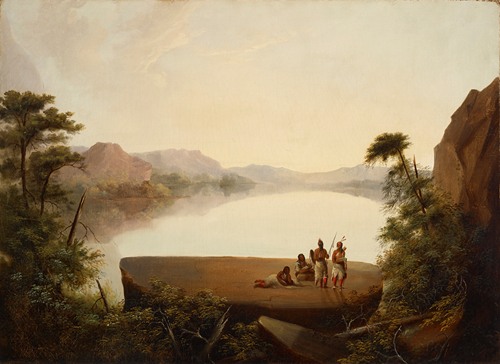
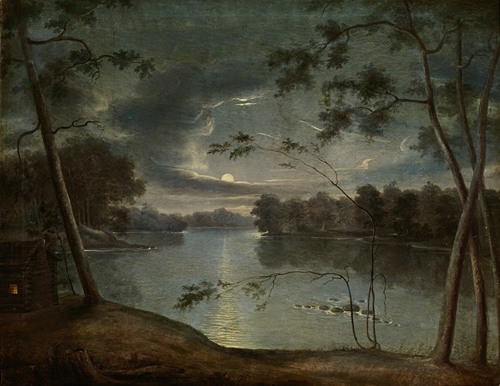

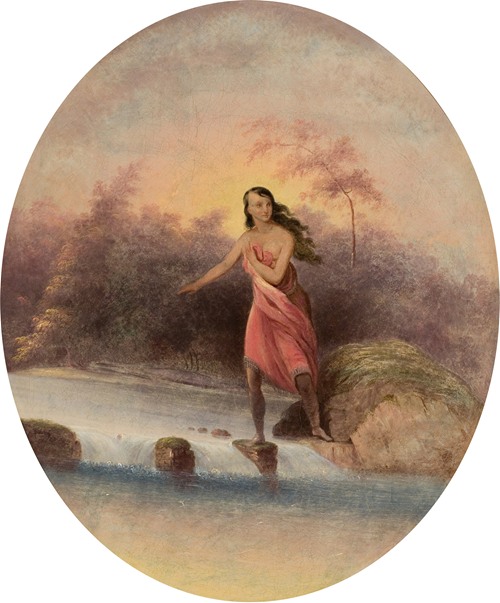
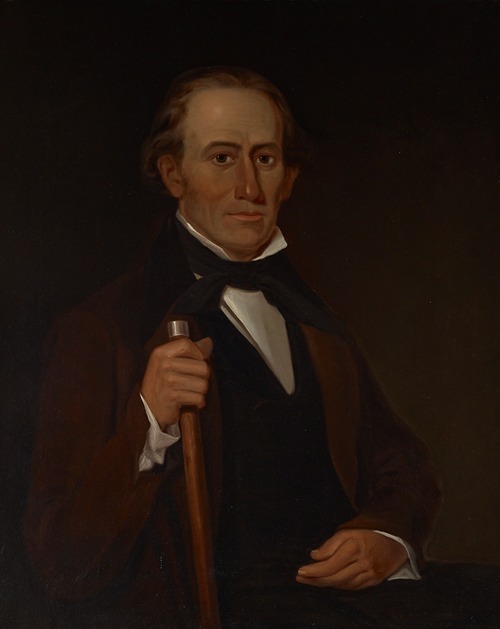
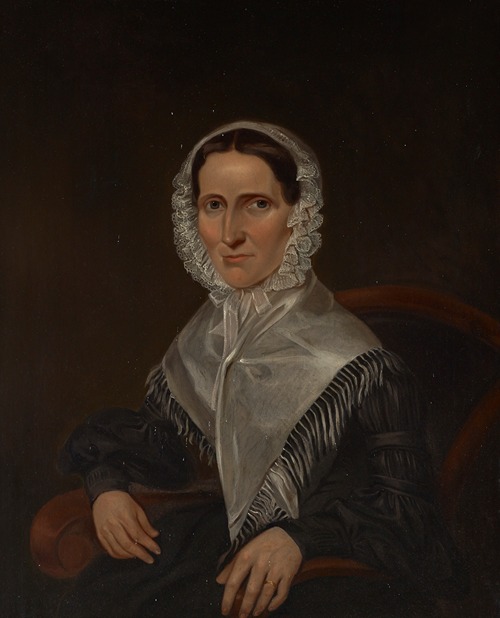
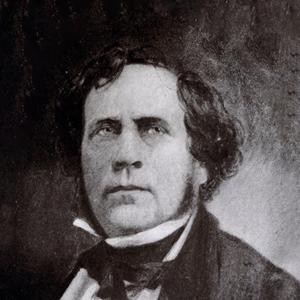

George Winter was an English-born landscape and portrait artist who immigrated to the United States in 1830 and became an American citizen in northern Indiana's Wabash River valley. Winter was one of Indiana's first professional artists. In addition, he is considered the state's most significant painter of the first half of the nineteenth century. Winter is especially noted for his sketches, watercolors, and oil portraits that provide a visual record of the Potawatomi and Miami people in northern Indiana from 1837 to the 1840s, as well as other figures drawn from his firsthand observations on the American frontier.
Winter is better known for the historic value and subject matter of his work, rather than his artistic skill and mastery of technique. Not well known outside of Indiana during his lifetime, Winter gained notice with his portrait of Frances Slocum, a Quaker who was abducted in Pennsylvania by Delaware (Lenape) warriors when she was a child and grew up to become the wife of a Miami chief in Indiana. The Slocum portrait, along with his other work, has appeared in several publications and art exhibitions. Winter's art and other materials are represented in public collections in Indiana (Haan Mansion Museum of Indiana Art), Wisconsin, and Pennsylvania.
Winter, the youngest of twelve children, was born on June 10, 1809, in Portsea, Portsmouth, England. As part of "a cultured family," Winter grew up "in an art atmosphere from early childhood." His early education took place in the local schools, but he also received private instruction and planned to continue art studies in London. When Winter's father and five of his siblings immigrated to the United States, Winter and other members of the family remained in England. In 1826 Winter moved to London, where he lived with his brother, John, and spent the next four years painting reproductions of art exhibited in the city's museum and galleries. Winter may have tried to gain admission to the Royal Academy of Arts in London, but it appears that he never formally trained as a painter.
In June 1830 winter immigrated the United States at the age of twenty-one. He exhibited one of his reproductions of J. P. Loutherbourg's Battle of Ascalon at the American Institute of the City of New York in October 1830, but studied art at the National Academy of Design in New York City. Winter also exhibited his early work at the National Academy's annual art exhibitions in 1832, 1834, and 1835. He moved to Cincinnati, Ohio, where his parents and other members of his family resided, in 1835. Winter opened an art studio, but found it difficult to make a living in Cincinnati as a portrait artist and illustrator. He closed the studio in 1837.
In May 1837 Winter decided to visit Logansport, Indiana. He had heard about the federal government's investigations of "irregularities" among Indian traders and the Potatawatomis, as well as the government's efforts to speed up the removal of the Potawatomi tribe from northern Indiana to reservation land in the Kansas Territory. Winter planned to observe and make sketches the Potawatomis during the legal proceedings. Although he only intended to make a brief stay before returning to the eastern United States, Winter remained at Logansport until 1850.
Winter married Mary Jane Squier, the daughter of Timothy and Rebekah Tucker Squier, on August 5, 1840, at Miamisburg, Ohio. Her father was a proprietor of stagecoach lines at Dayton, Ohio. Winter applied for U.S. citizenship in July 1841 and became a naturalized citizen. Winter and his wife established a home in Logansport. Their son, George Jr., was born on June 22, 1841; a daughter, Annette, was born on January 6, 1844. A second daughter, Agnes, died on July 24, 1850, at the age of seventeen months.
From 1837 to the late 1840s Winters observed the Potawatomi and Miami people on the northern Indiana frontier and kept detailed notes of his experiences in the field. Winter relocated to Logansport, Indiana, in May 1837 and observing and sketching the Potawatomis living in the surrounding area and documenting their culture. Winter observed the Potawatomis during the court proceedings investigating federal payments made to the Potawatomis prior to their removal west of the Mississippi River. In addition to documenting his sketches and paintings, Winter kept a journal and made notes about the subjects of his work, as well as other details of his encounters with Native Americans and others. Winter also painted portraits of the Potawatomis at a studio he established near a local trading post.
During the summer of 1837 Winter accompanied government representatives to a council meeting with the Potawatomis at Lake Kee-wau-nay (Indiana's present-day Lake Bruce), where the government officials hoped to persuade the Potawatomis to emigrate to Kansas Territory. Winter made more than seventy sketches as he observed the proceedings at the lake. In August 1837 Winter visited Crooked Creek, Indiana, the site of a Potawatomi removal camp. In November 1837 he was present when the final annuity payment was made to the Potawatomis in northern Indiana at Demoss' Tavern.
In 1838 Winter witnessed the beginning of the forced march of the Potawatomis to Kansas Territory and sketched the exodus as they passed through Logansport. The long march would later be called the Potawatomi Trail of Death. Instead of continuing his observations of Native Americans after their removal to the western United States, Winter remained at Logansport to paint portraits of local residents. He also wrote a series of published articles that appeared in the Logansport Telegraph, possibly to supplement his income as an artist. In 1839 Winter was commissioned to paint a portrait of Frances Slocum, the "Lost Sister of Wyoming," at her home near Peru, Indiana. Slocum was the subject of his most valuable and best-known work.
In connection with William Henry Harrison's presidential campaign in 1840 and subsequent election, Winter spent a week sketching the site of the Tippecanoe (1811), where Harrison earned his reputation as a military hero. Winter hoped to make a financial profit from exhibiting and selling six large canvases he had painted from the battleground sketches he had made. In a private letter Winter noted that two of them had dimensions of 152 square feet (14.1 m2) each. He also described the collection as being taken from different points of view to convey the idea of the battleground and the "surrounding romantic country." The large size of the paintings suggests that they were intended for public display, but Winter's efforts to make a profit from them ultimately failed. Later, they were seized by Winter's creditors. The Indiana state government acquired one of the paintings in 1849, but it has not survived. The fate of the other five paintings is unknown.
Although Winter exhibited two paintings at the Cincinnati Academy in 1841, and joined the city's Western Art Union, organized in 1847, he made few sales and struggled to make a living as a painter in Logansport. After some of Winter's possessions were seized to cover a portion of his debts, the family temporarily resided with Mary's father, Timothy Squier, who had retired to New Carlisle, Ohio. Winter and his family recovered from their financial difficulties and returned to Logansport in 1845.
Hoping to find more clients for his work, Winter opened a studio in Lafayette, Indiana, in 1850. His family remained at Logansport until 1852, then moved into a home on Lafayette's Main Street. Except for occasional travel and a brief residence in California in 1875–76, Winter lived in Lafayette from 1850 until his death in 1876.
To earn additional income in the early 1850s, Winter presented a traveling "mixed media" show called "Elydoric Paintings and Dissolving Views." It opened in Lafayette in November 1851 and appeared in several other Indiana cities, such as Indianapolis, Crawfordsville, and Marion. The show included four large canvases that Winter painted of classical and modern European scenes. After the show closed in October 1852, he returned to painting.
During the period 1852–58, Winter earned money to support his family by raffling off his paintings, usually at $2 per ticket, at various locations in Indiana, Iowa, and Ohio. Winter also visited Wisconsin in 1856, and opened a studio at Burlington, Iowa, but Lafayette, Indiana, remained the main location for the distribution of his work. Winter's largest raffle took place in Lafayette in 1868; the last of his raffles took place in 1873. It has been estimated than more than 500 of Winter's paintings were distributed in this manner over a twenty-two year period. To create the large volume of art for the raffles, Winter reworked his older material, made reproductions from prints and other works of art, and produced new portraits, landscapes, and genre scenes from sketches he made in the field. Although the scenes were based on his observations, Winter also modified his paintings to include "touches of fancy."
When his brother, Charles, died in San Francisco, California, in 1874, Winter traveled west to settle the estate and inherited his brother's California home. George returned to Indiana in 1875 and brought his wife, Mary, to Oakland, California, where they stayed for more than a year. During his brief residency in California, Winter became a member of the San Francisco Art Association and exhibited ten works of art at its exhibition in 1875.
Winter and his wife returned to Lafayette on January 26, 1876. He died unexpectedly of apoplexy on February 1, 1876, while attending a meeting of railroad stockholders at Snyder's Opera House in Lafayette. Following funeral services at Lafayette's Saint John's Church, he was buried in the city's Greenbush Cemetery.





